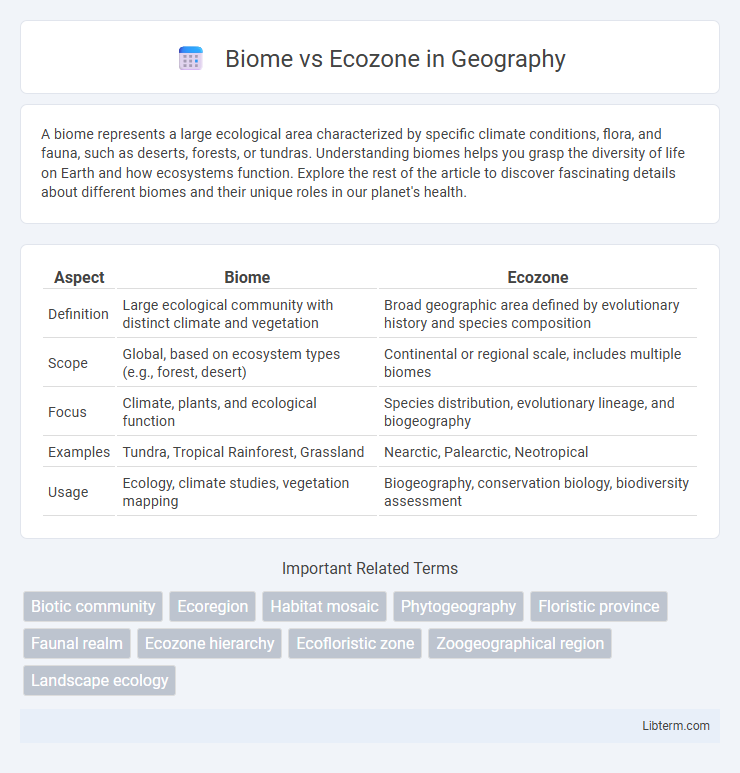A biome represents a large ecological area characterized by specific climate conditions, flora, and fauna, such as deserts, forests, or tundras. Understanding biomes helps you grasp the diversity of life on Earth and how ecosystems function. Explore the rest of the article to discover fascinating details about different biomes and their unique roles in our planet's health.
Table of Comparison
| Aspect | Biome | Ecozone |
|---|---|---|
| Definition | Large ecological community with distinct climate and vegetation | Broad geographic area defined by evolutionary history and species composition |
| Scope | Global, based on ecosystem types (e.g., forest, desert) | Continental or regional scale, includes multiple biomes |
| Focus | Climate, plants, and ecological function | Species distribution, evolutionary lineage, and biogeography |
| Examples | Tundra, Tropical Rainforest, Grassland | Nearctic, Palearctic, Neotropical |
| Usage | Ecology, climate studies, vegetation mapping | Biogeography, conservation biology, biodiversity assessment |
Definition of Biome
A biome is a large ecological area defined by its distinct climate, vegetation, and animal life, such as forests, deserts, or tundras. It represents a classification based on similar environmental conditions and adaptive life forms rather than geographic boundaries. Unlike ecozones, which are broader biogeographic regions encompassing multiple biomes, biomes emphasize ecosystem structure and function.
Definition of Ecozone
An ecozone, also called a biogeographic realm, is a large spatial region defined by the evolutionary history and distribution of terrestrial organisms, including plants, animals, and microorganisms. Unlike biomes, which are categorized primarily by climate and vegetation types, ecozones reflect broader ecological and evolutionary patterns shaped by geological history and barriers to species dispersal. Examples of ecozones include the Nearctic, Palearctic, Neotropical, Afrotropical, and Australasian realms, each containing multiple biomes within their boundaries.
Key Differences Between Biome and Ecozone
Biome refers to large ecological areas characterized by distinct climate, flora, and fauna, such as deserts, forests, and grasslands, while ecozone is a broader biogeographic division that encompasses multiple biomes within a continent or region based on evolutionary history and species distribution. Biomes are classified primarily by vegetation type and climate conditions, whereas ecozones consider historical and geographic factors influencing biodiversity patterns. Understanding these distinctions aids in ecological research, conservation planning, and managing biodiversity across different spatial scales.
Classification Criteria for Biomes
Biomes are classified primarily based on dominant vegetation types, climate patterns including temperature and precipitation, and ecological processes, while ecozones represent large geographic regions defined by the evolutionary history and distribution of organisms. The classification criteria for biomes emphasize abiotic factors such as climate, soil type, and moisture availability, which shape the community structure and species adaptations. In contrast, ecozones integrate both biotic and abiotic factors highlighting geographic boundaries that influence biodiversity and phylogenetic relationships.
Classification Criteria for Ecozones
Ecozones are classified based on large-scale biogeographic patterns, emphasizing the evolutionary history and distribution of species, both flora and fauna, across continents and major landmasses. This classification relies heavily on geographic boundaries shaped by natural barriers such as oceans, mountain ranges, and deserts, which influence species dispersal and genetic divergence. Unlike biomes that focus primarily on climate and vegetation types, ecozones emphasize historical lineage and ecological processes that define distinct ecological regions on a global scale.
Geographic Distribution of Biomes
Biomes are large ecological areas defined by specific climate conditions, flora, and fauna, distributed globally across continents such as the tundra in the Arctic, tropical rainforests near the equator, and deserts in subtropical regions. These biomes are characterized by factors like temperature, precipitation, and soil types, influencing the geographic distribution of diverse ecosystems. Unlike ecozones, which classify Earth's surface into broad biogeographical regions based on evolutionary history and species distribution, biomes emphasize climate-driven vegetation patterns and ecological functions across distinct geographic zones.
Geographic Distribution of Ecozones
Ecozones represent the broadest geographic distribution of ecological regions, encompassing vast areas of the Earth's surface defined by shared evolutionary history and distinctive assemblages of flora and fauna. Unlike biomes, which classify ecosystems based on climate and vegetation types, ecozones integrate biogeographical data to reflect continental-scale biodiversity patterns influenced by geological and evolutionary processes. This global framework divides the world into regions such as the Nearctic, Palearctic, Neotropical, Afrotropic, Indomalayan, Australasian, Oceanian, and Antarctic ecozones, each characterized by unique species distributions shaped by geographic isolation and environmental history.
Ecological Importance of Biomes
Biomes represent large ecological areas characterized by distinct climate, flora, and fauna, playing a critical role in sustaining Earth's biodiversity and regulating climate patterns. They provide essential ecosystem services such as carbon sequestration, oxygen production, and habitat for countless species, influencing global ecological balance. Unlike ecozones that classify regions based on evolutionary history and species composition, biomes emphasize functional ecosystems that support life processes vital to environmental stability.
Ecological Importance of Ecozones
Ecozones represent large-scale ecological regions characterized by distinct biotic and abiotic components, playing a crucial role in preserving global biodiversity and enabling large-scale ecological processes. They support unique species assemblages and evolutionary patterns, contributing to ecosystem resilience and climate regulation. Protecting ecozones ensures the maintenance of ecological services essential for human well-being and the balance of Earth's natural systems.
Human Impact on Biomes and Ecozones
Human activities such as deforestation, urbanization, and agriculture significantly alter biomes by disrupting native flora and fauna, leading to habitat loss and biodiversity decline. Ecozones, broader eco-regions defined by genetic species composition and evolutionary history, experience shifts in species distribution and ecosystem services due to climate change and pollution driven by industrialization. Conservation efforts targeting biome restoration and ecozone preservation are critical to mitigating anthropogenic impacts and maintaining ecological balance on a global scale.
Biome Infographic

 libterm.com
libterm.com